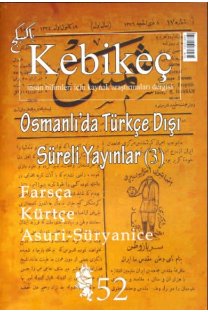Torino At ı ’nda Bir Felaketin Tasviri
Béla Tarr’ın son filmi olduğunu duyurduğu Torino Atı, esinini Friedrich Nietzche’nin Torino sokaklarında kırbaçlandığını gördüğü bir atın boynuna sarılıp gözyaşlarına boğulması sonrasında hayatının sonuna dek kurtulamayacağı bir ruhsal çöküntüye savrulduğunu anlatan anekdottan alır. Ancak film alışılmışın dışına çıkarak ilgisini Nietzsche’den ziyade atın akıbetine yöneltir. Bu makale, filmdeki atın varlığı sembolik yahut alegorik bir okuma ile silinmediğinde, filmin bir felaket anlatısı olarak belireceğini savunmaktadır. Bu felaket, on dokuzuncu yüzyıl sonu Avrupa’sında kaderleri iç içe geçmiş insan ve atın ortak kaderidir.
Description of a Disaster in The Turin Horse
The Turin Horse, which Béla Tarr announced as his last film, is inspired by the anecdote that Nietzsche burst into tears and mentally collapsed after witnessing the whipping of a horse in Turin. The film takes an original approach to the anecdote by focusing on what might have happened to the horse afterwards. This article argues that the film would appear as a disaster narrative once the horse’s presence is not nullified through a symbolic or allegorical interpretation. This disaster reflects the common fate of human beings and horses in Europe at the turn of the twentieth century.
___
- Yüksel, Ahmet. “Anadolu’nun Eşeği, Katırı, Atı.” Kebikeç 17 (2004): 295-325.
- Young, Julian. Friedrich Nietzsche: A Philosophical Biography. New York: Cambridge University Press, 2010.
- Townsend, Chris. “Nietzsche’s Horse”. Los Angeles Review of Books. 25 Nisan 2017. Erişim tarihi 15 Nisan 2018. https://blog.lareviewofbooks.org/essays/nietzsches-horse.
- Tolstoy, Lev N. “Holstomer”, Üç Ölüm. çev. Günay Çetao Kızılırmak. İstanbul: İş Bankası Kültür Yayınları, 2015, 3-44.
- Rancière, Jacques. Ertesi Zaman. çev. Elif Karakaya. İstanbul: Lemis, 2014.
- Nietzsche, Friedrich. “The Anti-Christ: A Curse on Christianity.” The Anti-Christ, Ecce Homo, Twilight of the Idols and Other Writings. çev. Judith Norman. New York: Cambridge University Press, 2005.
- Nietzsche, Friedrich. “Ahlakdışı anlamda Doğruluk ve Yalan Üzerine.” çev. Oruç Aruoba. Cogito 16 (1998): 55-66.
- Nietzsche, Friedrich. Human, All Too Human: A Book for Free Spirits. çev. R. J. Hollingdale. New York: Cambridge University Press, 1996.
- Mitsuda, Tatsuya. “The Horse In European History, 1550-1900.” Yayımlanmamış doktora tezi, University of Cambridge, 2017.
- McShane, Clay ve Joel Tarr, The Horse in the City, Living Machines in the Nineteenth Century. Baltimore, MD: John Hopikins University Press, 2017.
- Kohn, Eric. “An Interview With Béla Tarr: Why He Says ‘The Turin Horse’ Is His Final Film.” Indiewire. 9 Şubat 2012. Erişim tarihi 19 Mart 2018. http://www.indiewire.com/ 2012/02/an-interview-with-bela-tarr-why-he-says-the-turin-horse-is-his-final-film-242518/
- Hockenhull, Stella. “Horseplay: Equine Performance and Creaturely Acts in Cinema.” Necsus (Bahar 2015). Erişim tarihi 20 Mart 2018. https://necsus-ejms.org/ category/spring2015-animals.
- Greene, Ann Norton. Horses at Work: Harnessing Power in Industrial America. Cambridge, MA: Harvard University Press, 2008.
- Freud, Sigmund. The “Wolfman” and Other Cases. çev. Louise A. Huish. New York: Penguin Books, 2003, 3-122.
- Encyclopaedia Britannica. “Boston fire of 1872.” 5 Nisan 2018. Erişim tarihi 15 Nisan 2018. https://www.britannica.com/event/Boston-fire-of-1872.
- Dostoyevski, Fyodor M. Suç ve Ceza. çev. Mazlum Beyhan. İstanbul: İş Bankası Kültür Yayınları, 2016.
- Dostoevsky, Fyodor M. A Writer’s Diary: Volume I, 1873-1876. çev. Kenneth Lanz, Evanston, Illinois: Northwestern University Press, 1993.
- Derrida, Jacques. The Animal That Therefore I am. çev. David Wills. New York: Fordham University Press, 2008.
- Berger, John. “Why Look at Animals?”. Why Look at Animals?. New York: Penguin Books, 2009, 12-38.
- ISSN: 1300-2864
- Yayın Aralığı: Yılda 2 Sayı
- Başlangıç: 1995
- Yayıncı: Mehtap Yüksel
Sayıdaki Diğer Makaleler
Global Tarihten Global Entelektüel Tarihe: Gelişimi ve İmkanları Üzerine
Şehrin Çöküşü ve Hafıza Mekânının İnşası: 1939 Erzincan Depremi Üzerine
Seller, Bataklıklar ve Dönüşen Tarım Bilgisi: Bursa ve Mihaliç
Felaketin Belleği: ‘66 Varto Depremi ve Etrafında Oluşan Kolektif Hafıza
Zaman-Mekan Genişlemesi Olarak Felaketin Tarihçesi
Sabiha Sertel ve Amerikan İşçi Hareketi
Felaketleri Yönetmek: Osmanlı Kent Yangınlarının Kullanımları (16-18. Yüzyıl)
